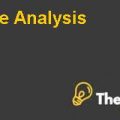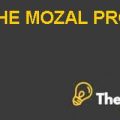
v) What order-up-to point maximizes the net profit on Great White?
(Ans-v)
Plotting a graph between Order up to points and Net Profits:
It is clear that the net profit $1,516.36 is maximum at the Order up to point 57
Q# b)
i) Evaluate Brown’s proposal that he should use the holding cost of one unit for the two-week period as the cost of overage in the newsvendor model. Calculate this overage cost for the Great White SKU.
(Ans-i)
The holding cost of one unit = cost of overage
Annual Holding Cost =0. 25*20 (Holding cost is 25%, and $20 is the cost per unit)
Annual Holding Cost = $5
This is the annual holding cost per unit holding cost for two weeks it would be (25 Bi weeks in a year)
| Co= 5/25 = $0.2 |
ii) Evaluate Brown’s proposal that he should use the margin on one unit (= retail price –wholesale price) as the cost of underage.
(Ans-ii)
Cost of underage = margin on one unit
=21 – 20 (21 is the retail price, and 20 is wholesale price)
| Cu= $1 |
iii) Calculate the critical fractile based on the underage and overage costs given (i) and (ii) above. This gives the optimal in-stock rate for those costs. The corresponding optimal order-up-to the point is the smallest order-up-to point that has an in-stock rate equal to or higher than the critical fractile. Use your table of order-up-to points and in-stock rates to find the optimal order-up-to point based on your calculated critical fractile.
(Ans-iii)
Critical fractile = Cu/(Co+Cu)
=1/1.2
| CF= 0.8333 |
This is the “Optimal In Stock rate” for this in stock rate; the order up to the point will be 60.
Q# c) What type of inventory policy, fill-rate service level, in-stock rate service level, or profit maximization criteria should Brown choose? What strategic product characteristics or overall retailing strategy could influence his decision?
(Ans-c)
The service level is used in inventory management to measure the performance of inventory policies; the optimal size of backorders can be derived from the optimal solution of such a model. This approach requires that the decision makers know the optimal value of the backorder costs. However, these costs are difficult to compute in practice. According to the previous practices, the P&M had maintained an average inventory level of about 80 reams of Great White, though the actual inventory level did fluctuate because of uncertain demand and incompatible ordering policies.
Saturday’s biweekly stocktaking confirmed that the product had always been in stock and thus had a 100% in-stock rate (i.e., the ratio of weeks during which the item did not stock out to the total number of weeks was 100%). An example of one type of service level measure retailers used, in-stock rate was often referred to as a “Type 1” service level. Fill rate, the percentage of demand satisfied from in-stock inventory, sometimes referred to as a “Type 2” service level, was also 100% for Great White over the two-year period. Although a 100% fill rate was ideal from a customer service perspective, Brown knew that he was paying a premium to hold inventory to meet that service level. Brown believed that a 98% fill rate (Type- 2) was the acceptable customer service, and sought to devise a simple, but consistent inventory policy to meet that goal.
Since customer loyalty for Great White was high, he further assumed that there was no substitution to another product in the event of a stock-out, so if customers found this product out of stock, they failed to purchase and their sales were lost to P&M. Brown wondered how much he could reduce inventory if his goal were to achieve a 98% fill rate. The inventory carrying cost data would give him a sense of the savings he might realize from lower inventory levels. Finally, Brown should choose profit maximization criteria as they are going to expand business, so acutely required capital to finance the expansion and cannot afford other options as additional capital will be bound in fill rate service level and stock rate service level.
Q# d) The foregoing analysis suggests a process for managing individual product inventory: Periodically determine the inventory, order-up-to point that meets the required inventory policy for that product on historical data and use this order-up-to point for the future. What concerns about the efficiency of the process might Brown still have, and how might he try to address them using his data?
(Ans-d)
Periodic Review
- Fixed order intervals
- Variable order sizes
- Convenient to administer
- Inventory position only required at review
Continuous Review
- Varying order intervals
- Fixed order sizes (Q)
- Allows individual review frequencies
- Possible quantity discounts
- Lower, less-expensive safety stocks
ABC Inventory Management............................
This is just a sample partial case solution. Please place the order on the website to order your own originally done case solution.












